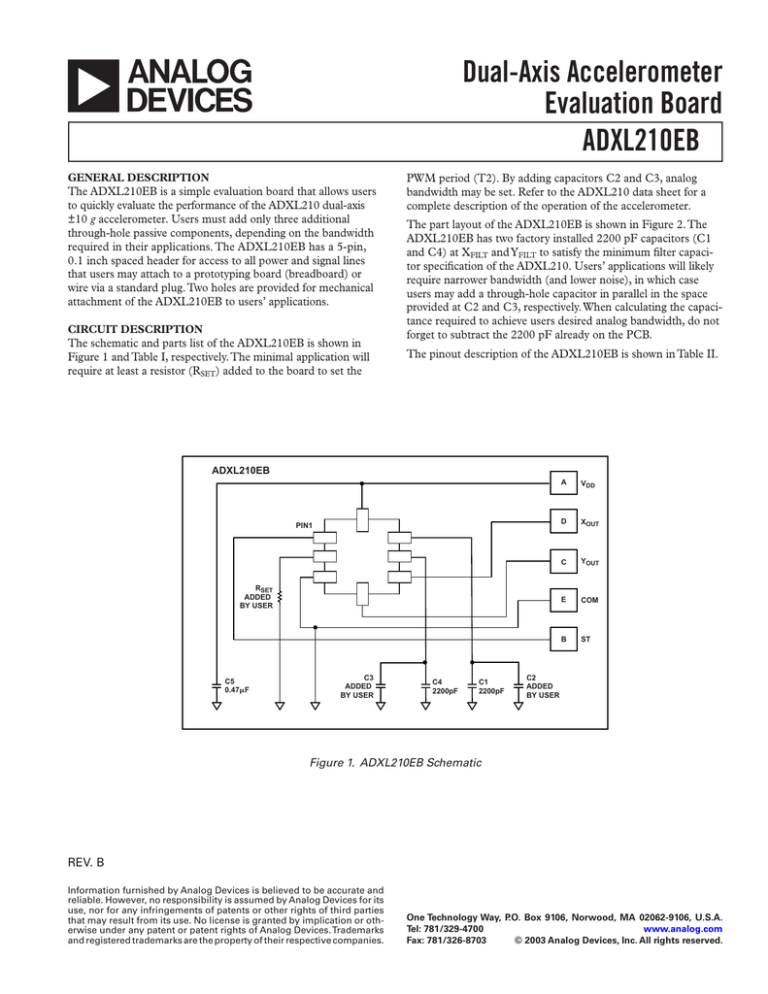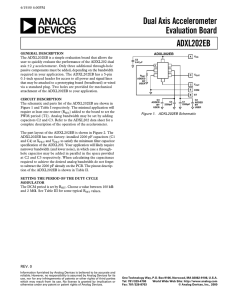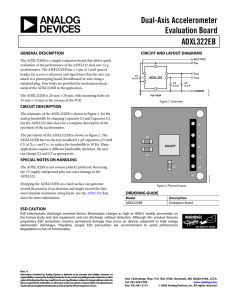
Dual-Axis Accelerometer
Evaluation Board
ADXL210EB
GENERAL DESCRIPTION
The ADXL210EB is a simple evaluation board that allows users
to quickly evaluate the performance of the ADXL210 dual-axis
±10 g accelerometer. Users must add only three additional
through-hole passive components, depending on the bandwidth
required in their applications. The ADXL210EB has a 5-pin,
0.1 inch spaced header for access to all power and signal lines
that users may attach to a prototyping board (breadboard) or
wire via a standard plug. Two holes are provided for mechanical
attachment of the ADXL210EB to users’ applications.
CIRCUIT DESCRIPTION
The schematic and parts list of the ADXL210EB is shown in
Figure 1 and Table I, respectively. The minimal application will
require at least a resistor (RSET) added to the board to set the
PWM period (T2). By adding capacitors C2 and C3, analog
bandwidth may be set. Refer to the ADXL210 data sheet for a
complete description of the operation of the accelerometer.
The part layout of the ADXL210EB is shown in Figure 2. The
ADXL210EB has two factory installed 2200 pF capacitors (C1
and C4) at XFILT and YFILT to satisfy the minimum filter capacitor specification of the ADXL210. Users’ applications will likely
require narrower bandwidth (and lower noise), in which case
users may add a through-hole capacitor in parallel in the space
provided at C2 and C3, respectively. When calculating the capacitance required to achieve users desired analog bandwidth, do not
forget to subtract the 2200 pF already on the PCB.
The pinout description of the ADXL210EB is shown in Table II.
���������
����
����
�����
�� ����
��
������
��
�����
�� ����
��
������
��
������
�
���
�
����
�
����
�
���
�
��
��
�����
�� ����
Figure 1. ADXL210EB Schematic
REV. B
Information furnished by Analog Devices is believed to be accurate and
reliable. However, no responsibility is assumed by Analog Devices for its
use, nor for any infringements of patents or other rights of third parties
that may result from its use. No license is granted by implication or otherwise under any patent or patent rights of Analog Devices. Trademarks
and registered trademarks are the property of their respective companies.
One Technology Way, P.O. Box 9106, Norwood, MA 02062-9106, U.S.A.
Tel: 781/329-4700
www.analog.com
Fax: 781/326-8703
© 2003 Analog Devices, Inc. All rights reserved.
ADXL210EB
Reference Value
Function
C1
C2
C3
C4
C5
J1
R1
U1
XFILT. Sets X-axis analog bandwidth along with C2.
XFILT. Sets X-axis analog bandwidth along with C1.
YFILT. Sets Y-axis analog bandwidth along with C4.
YFILT. Sets Y-axis analog bandwidth along with C3.
Power Supply Decoupling
All Power and Signal Connection through J1
RSET. Sets the PWM period (T2).
Dual-Axis ±10 g Accelerometer
2200 pF/25 V
Added by User
Added by User
2200 pF/25 V
0.1 µF/25 V
Connector
Added by User
ADXL210
��
Table II. ADXL210EB Pinout Description
��
��
��
��
��
��
��
�
�
�
�
C03573–0–2/03(B)
Table I. ADXL202EB Parts List
�
Pin Reference
Function
E
B
D
C
A
Ground
Self-Test Input
X-Axis Duty Cycle Out
Y-Axis Duty Cycle Out
+V Supply (3 V dc to 5.25 V dc)
Figure 2. ADXL210EB Part Layout (Top View)
Table III. DCM Period vs. RSET Value
SETTING THE PERIOD OF THE DUTY CYCLE MODULATOR
RSET sets the DCM period. Choose a value between 100 k and
2 M. See Table III for some typical RSET values.
T2 Period (ms)
RSET
1
2
5
10
124 k
248 k
620 k
1.24 M
SETTING THE ADXL210’S BANDWIDTH
Table IV. Typical XFILT and YFILT Values vs.
Bandwidth and Noise Performance
The ADXL210EB is supplied with the minimum specified XFILT
and YFILT values installed. Users’ applications will likely require a
narrower bandwidth to improve noise performance. See Table IV
for some typical capacitor values.
SPECIAL NOTES ON HANDLING
The ADXL210EB is not reverse polarity protected. Reversing the
+V supply and ground pins will damage the ADXL210.
XFILT, YFILT
(µF)
Bandwidth
(Hz)
RMS Noise
(mg)
0.01
0.047
0.1
0.47
500
100
50
10
12.7
7
4.2
2.3
PRINTED IN U.S.A.
Dropping the ADXL210EB on a hard surface may generate
several thousand g of acceleration; enough to damage the accelerometer. Please refer to the ADXL210 data sheet for information
on shock survivability.
–2–
REV. B




